Hidden Springs Homestead may earn a commission for purchases made after clicking links on this page. Learn More.
Nothing is more frustrating than picking a tomato off the vine only to find that it is rotting from the inside out and has this pencil eraser size hole in it! The culprit that causes this kind of tomato fruit problem is the tomato fruitworm—also known as the armyworm. Learn how to kill tomato fruitworms easily!
How do you kill tomato fruitworms organically, and how do you control them, so they don’t destroy your tomato crop?
3 pests that Can Destroy Tomatoes
Tomato crops have 3 main enemies, the squash bug, the tomato hornworm, and the tomato fruitworm. Today I’ll discuss the tomato fruitworm.
Also known as the corn earworm or armyworm, it’s a caterpillar that eats on both the leaves and the tomato fruit. The holes can be shallow on the surface, even deep into the center.
Not only does it leave a nasty hole in your tomato, but it will also immediately begin to rot from the inside out. Knowing the signs is part of the process of getting rid of them or killing them all together.
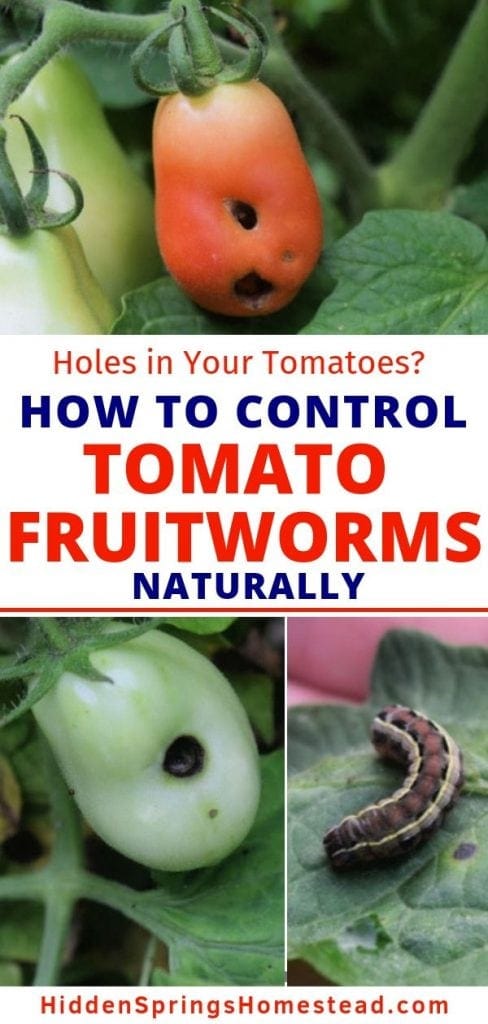
What are tomato fruitworms?
Tomato fruitworms are horrible! They are sneaky, hide really well, and appear, it seems, out of nowhere.
If left undetected for only a few days, they can wreak havoc on your whole tomato crop. Have you noticed a tomato beginning to ripen on the vine only the next day to find this same tomato has already begun to rot? If so, you’ve got a pesky tomato fruitworm lurking around on your plant.
How to identify tomato fruitworms
So what does this armyworm look like? The young or small caterpillar has very distinct rows of dark bumps on its back, and the older ones will have dark gray or yellow to light brown stripes that run lengthwise on its whole body.
They can be even yellow, green, and even reddish-brown in color and grow to about 1.5 – 2 inches long in size.
Many people refer to them as “black worms on tomatoes.”
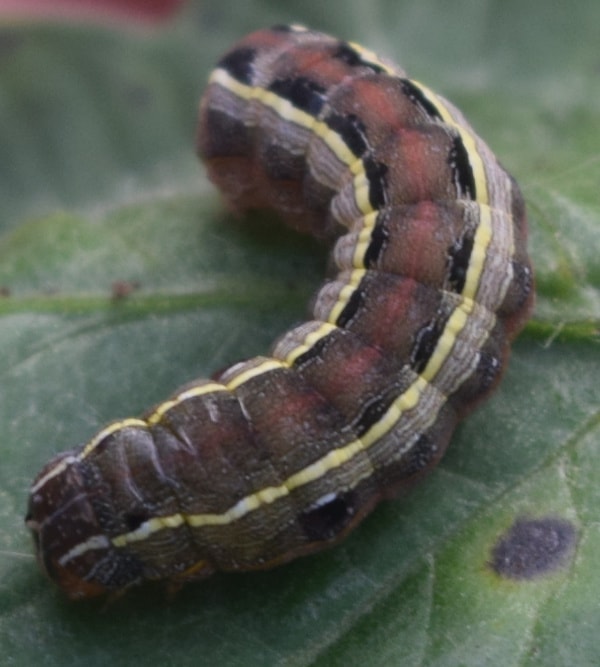
Lifecycle of Tomato Fruitworms
Adult
Tan-gray-colored moth with a single black spot in the center of each wing. Some say this look like eyes on its wings. The wing span is around 1.5 inches in total.
The adult moth lays its eggs on tomatoes as well as beans, peppers, squash, corn, lettuce, peas, potatoes, as well as several other crops. They are not picky!
They are nocturnal, meaning they lay their eggs right at dusk.
Eggs
The eggs of an adult moth are off-white with a slightly flat look, round shaped just about the size of a pin head, so very tiny and hard to see.
They are easier to spot right before they hatch when they develop a reddish-brown stripe on them, which makes them more noticeable.
Larva
The larva (worm) hatches into this tiny small, light-colored with a brown or dark-colored head covered in hairs. The larva is what destroys your plants.
They feed off not only on the fruit but also the stem as well as the leaves. It feeds on plants first and then moves to your tomatoes once they begin to ripen.
This is why many tomatoes that are not totally ripe but pink in color are attacked. They prefer the fruit when it is going from green to barely ripe. Of course, they do destroy green tomatoes too.
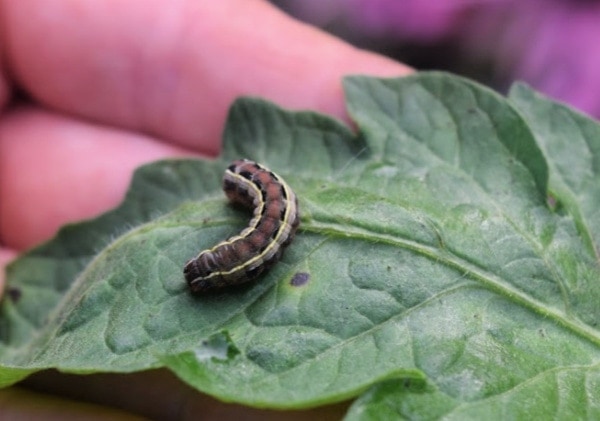
Can you eat tomatoes with holes in them? Once it eats its way into your tomato, it is no longer good. It should be thrown away. You should not eat tomatoes with holes in them!
When they are finished feeding, they drop to the ground near the plant and form a cocoon to start the cycle over again in about 14 days. One season can have multiple generations.
Pupa
The pupa is a brown cocoon that overwinters in the soil about 2-3 inches deep for protection. And in the spring, it emerges to begin the cycle again.
Damage Done to plants by Tomato Fruitworms
The most noticeable damage is small holes in ripening fruit. We don’t seem to notice as much when they are feeding on the plant itself.

You can often cut the tomato open and find distinct tunneling through it, with clear juice, frass, and rot of the tomato itself.
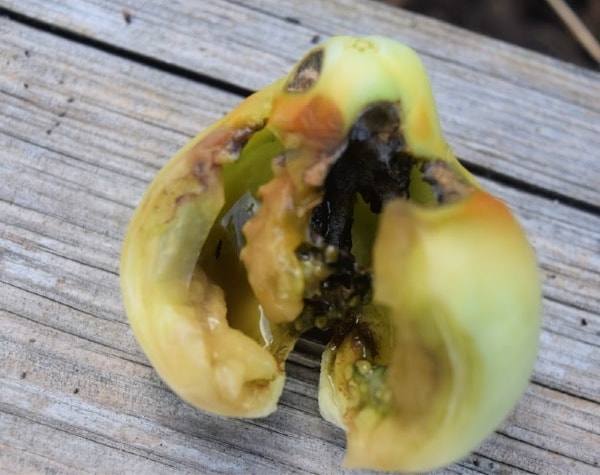
How to kill tomato fruitworms organically
1) Attract Natural predators
Fortunately, tomato fruitworms do have natural predators. Attracting these to your garden can be a huge help in controlling these pesky things.
- parasitic Trichogramma wasp
- big-eyed bugs
- minute pirate bugs
- damsel bugs
- lacewings
2) How to Prevent tomato fruitworms
- Minimize their food source. Avoid planting near corn or cotton – the corn plant is their favorite. So keep tomatoes as far away as possible.
- Watch for eggs on both sides of the leaves – begin by looking closest to the bloom. Pick off any leaves found with eggs and destroy them.
- You can use cover cloths to keep the adult moth from laying eggs on your plants.
3) How to Get rid of tomato fruitworms
- 1) Watch for larvae, which look like tiny worms
- 2) Apply Bt- Bacillus thuringiensis – liquid- this does break down in UV light – so you will need to apply it every few days at the first sign of eggs
- 3) Use Neem Oil or Insecticidal soap (see recipe below) once a week and after each rain
- 4) Apply Diatomaceous Earth around the base of the stems to kill the larva
- 5) Hand-picking when you can find them
To attract these natural predators to your garden plant – grow lots of dill, parsley, asters, goldenrod, daisies, alfalfa, and stinging nettles near the garden or very close to your tomatoes.
Not only are these flowers helping to control the fruitworm, but the goldenrod and alfalfa will also feed pollinators into late fall.
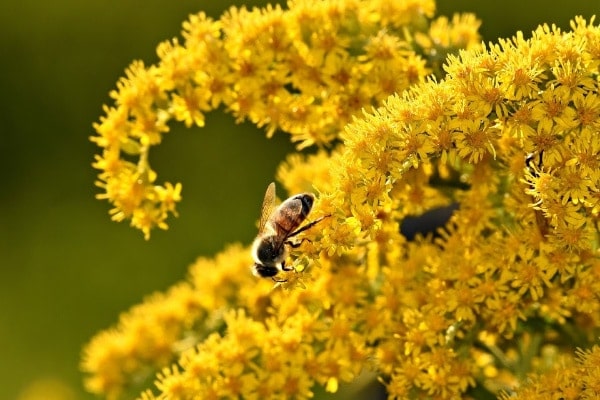
RELATED: Even if you’ve never gardened before, this Vegetable Gardening for Beginners Ultimate Guide is for you! Learn everything you need to know from over 60 resources, all in one place, to be a successful gardener, including improving soil, cover crops, warm and cool season crops, organic amendments, fertilizing, watering, garden pests and diseases and so much more.
You Don’t have to let Tomato fruitworm win
I know it can be very frustrating to feel like your tomato crop is being destroyed by all these tiny holes in your tomatoes.
Don’t give up! Start the season early by looking for eggs and those “moths” that flit around at dusk. If you can destroy the eggs before they hatch, you are way ahead in controlling tomato fruitworms.
Plant lots of flowers to attract their natural predators, and you’ll enjoy harvesting your delicious tomatoes every season.
So there you have it! Controlling and killing tomato fruitworms is possible with just a little knowledge and preparation. What will you do to better prepare to control them and kill them in your garden?
Easy to Make Insecticidal Soap
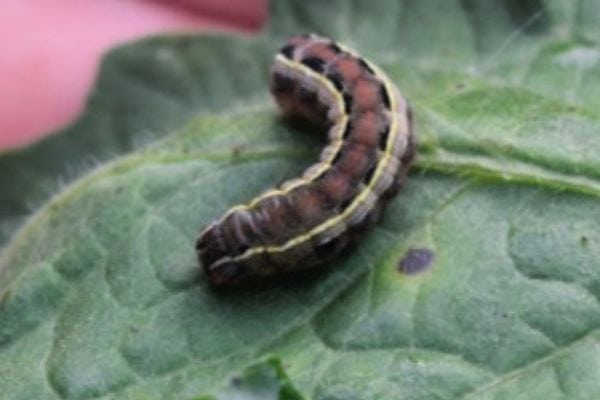
Control Tomato Fruitworms easily using this easy-to-make insecticidal soap weekly!
Materials
- 5 TBSP Castile Soap
- 1 Gallon Water
Tools
- Garden Sprayer
Instructions
- Fill the sprayer with 1 gallon of water
- Add Dr. Bronner's Castile Soap
- Shake to mix well
- Spray directly on stems, leaves (top and bottom), and fruit
Notes
Spray every 5-7 days and after each rain.
Recommended Products
As an Amazon Associate and member of other affiliate programs, I earn from qualifying purchases.
More Gardening tips
- How to Grow Tomatoes
- 11 Common Mistakes Made Growing Tomatoes
- Growing Potatoes, All You Need to Know
- How to Grow Cabbage in the Home Garden
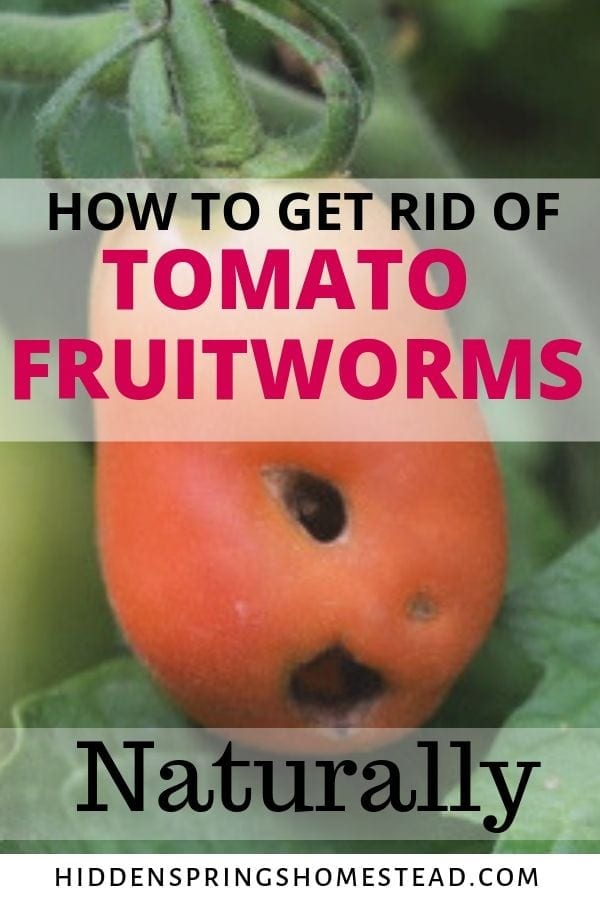
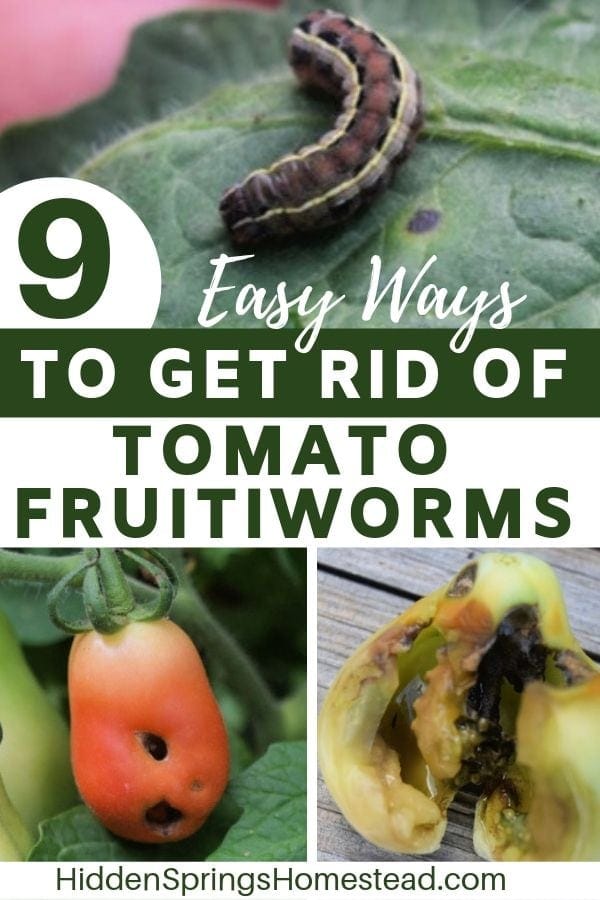
Connect with Hidden Springs Homestead!
Be sure to follow me on social media so you never miss a post!

Dianne Hadorn is the owner of Hidden Springs Homestead nestled in the hills of East Tennessee. She is a Master Gardener and enjoys helping others learn how to grow and preserve their own food and sharing tips for living a more self-sufficient lifestyle.


Thanks for your advice. I have grown tomatoes for years and this year is the first I’ve had these. We solved the ‘bird’ problem by netting the plants, and then came these awful things. I was nuts trying to figure it out as we had a huge crop of beautiful tomatoes. I did find that the BT worked but I also sprayed with Neem Oil. I still find a hole here and there but I just keep spraying!!
Hello Dianne, 2 days ago I found 1 of my 3 tomatoe plants overran with the fruitworm so bad that I had to remove from the large container that housed 3 plants, I searched the two left removed all worms (I thought) and sprayed with Neem Oil, this morning checked them and worms on the other two. I Did find the little black dots you talk about. At this point I feel like I’m fighting a loosing battle. (boy I was going to have a decent yield this time around). If I remove the 2 remaining and start again, do I need to start with new soil in my container? HELP!!
Hi Vicki,
I’m sorry you have fighting these pesty things! They do overwinter in the soil, but since you mention they are in a large container, did you begin with a new soil this season? What I would do is continue to keep these plants and continue to “pick” them off as you find them. Be persistent and consistent. They will grow larger and easier to find and then I would also start a new – separate container with “new soil and new plants – you’ll have some “late tomatoes.” And do it as an experiment. This way, maybe they will not devour your whole crop. One to share with them and another to keep for yourself.
Thank you so much for your tips. I have found that tomatoes are the hardest plant to grow. I decided to grow a patio tomato this time. I noticed those dreaded holes in the green immature tomatoes. I also found one of those worms as described. So, my question is, do they also eat green tomatoes. It appears that they do. Tried neem oil yesterday, and today is the first time I actually saw the worm.
Hi Carolyn,
Unfortunately yes, they eat both green and ripe tomatoes. They leave a little black dot of feces on the leaves. If you spot this on any of the leaves, be sure to look the entire plant over closely starting with specifically where you find the poop. They are tiny black worms until they get a bit bigger to have their stripe.
They can ruin a crop in no time.
Dianne
Thanks for these tips Dianne. I’m growing a very small crop of tomatoes at the moment and thus far no problems, but I’m growing them in my greenhouse so I wonder if that has anything to do with it. Regardless, these worms sounds like a pain! At least I know what to look out for now.
Do you know if tomato fruit worms are worldwide? Or just in certain countries?
Hi Kevin,
The green house does help. As long as you can prevent the adult moth from getting to your plants you should be ok. When you open your greenhouse for air movement, a good thing to do is have screens over the openings. You are right, they are a pain! They hide so well, hard to find and just make a mess of ripening tomatoes. Of course, they are not only on tomatoes, they will cover corn, legumes, and several other plants as well. They are not real picky on what they consume.
I’m sorry, but not sure about them being worldwide. I know here in the states they are more in our warmer zones. Since they overwinter in the soil, they cannot survive the freezing temps further north.
Hope this helps. Thank you for reading my article. Please feel to ask questions anytime. I’ll do my best to help.
Dianne
Great advice, thanks very much Dianne! I’ve only ever tried growing tomatoes in my greenhouse so I’m guessing that’s why I’ve had good luck so far..
I’m in the UK and I think I’m zone 7 or 8, and our frosts can be unpredictable. We can still be getting frosts in May sometimes!
Thanks again Dianne, I’m sure I’ll have more questions soon 🙂